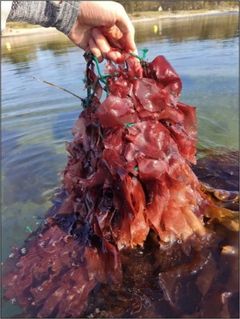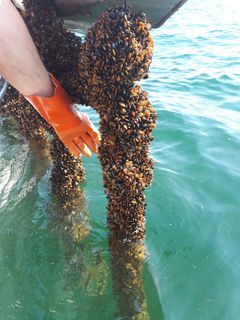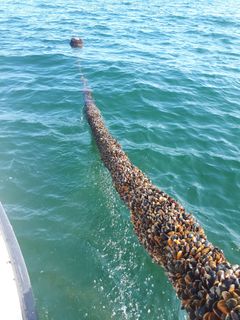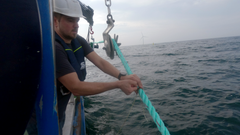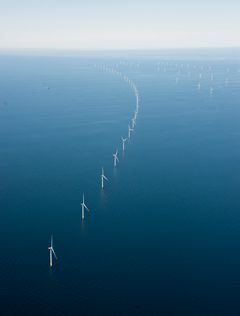Seaweed can contribute to biodiversity and climate-friendly foods: New project is only one in a string of innovation projects at Anholt Offshore Wind Farm
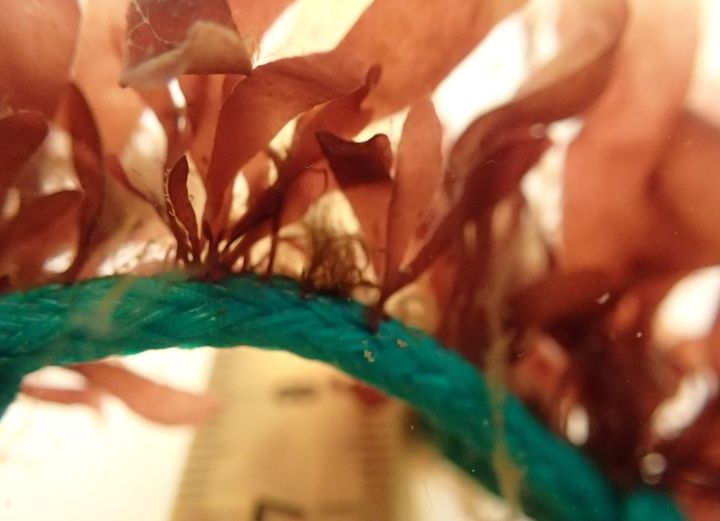
A new research project at Anholt Offshore Wind Farm in Denmark aims to grow a number of less carbon-intensive foods while contributing to a healthier marine environment: To solve the climate crisis, we need to look at how we source our energy, but also at what we eat, as many foods emit large amounts of carbon dioxide during their production. Another goal of the project is to protect the marine environment, which is under tremendous pressure. Seaweed is highly effective at sequestering carbon dioxide and nutrients and creates new habitats for marine species.
Placing the project at Anholt Offshore Wind Farm, which has delivered renewable electricity for a decade, is far from coincidental.
Ingrid Reumert, Senior Vice President and Head of Global Stakeholder Relations at Ørsted, says:
“We’ll be constructing a lot of offshore wind farms over the next several years. If we can use the same areas at sea which are already being used to generate renewable energy to produce new, climate-friendly foods such as seaweed and mussels while simultaneously protecting the marine environment, we can really make a difference.”
Seaweed and mussels as climate-friendly foods
As part of the ULTFARMS project, researchers from the Technical University of Denmark (DTU) are currently busy putting out lines of up to 100 metres – in sometimes very windy conditions – in the water around the 111 wind turbines that make up Anholt Offshore Wind Farm. The researchers attach seedlings to the lines to cultivate three different types of seaweed which can be used for human consumption. Next spring, the plan is to start the cultivation of blue mussels by supplementing the seaweed with material that mussel larvae in the seawater can settle on. Common to both seaweed and the blue mussel is that producing them requires very little energy, and they are therefore particularly suitable as foods of the future.
Jens Kjerulf Petersen, professor at DTU, says:
“Seaweed is a plant that absorbs carbon dioxide directly, while cultivating mussels requires very little energy – they feed on what’s already in the sea, which is why they’ve been selected for this project. The area around Anholt has been chosen because the water has the right salinity for cultivating mussels and seaweed.”
Investors take responsibility for both renewable electricity and the marine environment
Anholt Offshore Wind Farm is owned by three partners: Ørsted, PensionDanmark, and PKA. The new innovation project seeks to take responsibility for the marine environment while also finding new ways to produce more climate-friendly foods. The hope is that projects like these will show that it is possible to integrate the marine environment into the design of renewable energy projects early on, thereby enabling faster administrative processes and consenting times for a sustainable build-out of offshore wind.
Jan Kæraa Rasmussen, Head of ESG & Sustainability at PensionDanmark, says:
"Offshore wind is a key to a green Europe independent of Russian gas, and we need to build at a scale never seen before. At the same time, the marine environment in Denmark is under pressure, and it therefore makes sense for us as responsible investors to engage in projects that investigate how we can ensure a build-out of renewable energy that isn’t only climate-friendly but also nature-friendly. And with this project, we'll add a new dimension to the narrative about Anholt Offshore Wind Farm as an innovation hub – both for large-scale offshore wind deployment and for a future healthy and vibrant marine environment around Denmark."
Dewi Dylander, Vice President and head of ESG in PKA, says:
"Denmark is an international leader in offshore wind, and now we can also be the first to take the next steps and show that offshore wind can deliver not only renewable electricity but also climate-friendly foods and a more flourishing marine environment. If the project is successful, we can use it to inspire offshore wind players globally so that it sets a leading example for the build-out of much more offshore wind around the world in the years to come."
Anholt Offshore Wind Farm – ten years of green energy, innovation, and sustainability
In addition to producing renewable energy corresponding to the annual power consumption of one million Danes, Anholt Offshore Wind Farm has played a role in several innovative and sustainable projects since it was inaugurated by HM Queen Margrethe II and HRH The Prince Consort ten years ago:
- Boulder reefs have attracted marine life around the offshore wind farm
During the construction of the offshore wind farm in the Kattegat, a strait between Denmark and Sweden, Ørsted (who was then known as DONG Energy) established 25 boulder reefs in the area.
Today, the reefs are teeming with marine life (See more here). - In 2022, Ørsted and the World Wide Fund for Nature (WWF Denmark) started testing how 3D-printed reefs can benefit biodiversity in the Kattegat, which is experiencing a historically low cod stock.
The hope is that the 3D-printed reefs will have positive effects on the Kattegat cod stock and in turn contribute to a healthier, more resilient marine ecosystem with improved biodiversity. - Using drones to reduce carbon emissions
Last year, Ørsted and DSV, the global Danish transport and logistics company, launched a trial at the wind farm to assess the role cargo drones can potentially play in sustainable logistics for offshore wind farms.
Offshore wind farms are usually located far from shore, and the service technicians and necessary spare parts are usually transported by ship. Technicians bring their tools and the components most often needed for the wind turbines, but if special spare parts are needed, they have to go back onshore to get them. This is both costly and time-consuming, and the repairs are therefore often delayed until the next day.
As an alternative, cargo drones can offer logistics support, especially for small spare parts, contributing to a much faster wind turbine restart.
In spring 2024, DTU will start harvesting seaweed at Anholt to determine whether ecological and economically sustainable cultivation of seaweed is possible in the water around the offshore wind turbines.
About Anholt Offshore Wind Farm
- Anholt Offshore Wind Farm is located in the Kattegat in Denmark between the peninsula Djursland and the island of Anholt and covers an area of 88 square kilometres.
- People from all over the world have visited Anholt Offshore Wind Farm since Ørsted installed the 111 wind turbines with a total capacity of 400 MW in 2012-2013.
- The power production from the wind farm is completely carbon-neutral and exceeds the annual consumption of more than one million Danes.
- When completed in 2013, the offshore wind farm was the world’s largest.
Today, the world’s biggest offshore wind farm is Hornsea 2, with a production of more than 1.3 GW. Hornsea 2 is located in the UK and is also owned by Ørsted. - The 111 wind turbines at Anholt have a rotor diameter of 120 metres and a hub height of 82 metres.
- 51 technicians and administrative staff work with operation and maintenance (O&M) of the wind farm, and the O&M base is located at the Port of Grenaa.
- Ørsted has developed and constructed Anholt Offshore Wind Farm and is responsible for its operation. The company owns 50 % if the wind farm, while the Danish pension funds PensionDanmark and PKA own the remaining 30 and 20 %, respectively.
About seaweed and blue mussels as sources of food
The cultivation of mussels and seaweed has a lower impact on the environment – and particularly the climate – than land-based agriculture, and they contain both healthy proteins and other nutrients. In addition, many fish stocks around the world are overfished, so to replace these stocks, we need new sources of food.
The following species of seaweed and mussel will be cultivated at Anholt Offshore Wind Farm:
- Sugar kelp (Saccharina latissima). Used in sushi, among other things.
- Dulse (Palmaria palmata). A natural flavour enhancer known as the ‘bacon of the sea’ because of its umami taste.
- Oarweed (Laminaria digitata). Also known as ‘kombu’. Used in soups and salads, among other things.
- Blue mussels. A well-known food that can be eaten steamed or fried.
Download photos of Anholt Offshore Wind farm and the projects here.
Read more about Anholt Offshore Wind Farm here.
About ULTFARMS
The ULTFARMS project at Anholt is part of a larger EU-funded project which aims to optimise the production of foods under harsh offshore conditions and to establish a profitable, sustainable, and ecological production chain at offshore wind farms located in the North Sea and Baltic Sea.
Read more here.
For further information, please contact:
Ørsted Global Media Relations
Thor R. Wilkens
+45 99 55 44 07
PensionDanmark Media Relations
Jacob Therkelsen
+45 31 12 67 08
PKA Media Relations
Nicholas Rindahl
+45 30 16 11 24
About Ørsted
The Ørsted vision is a world that runs entirely on green energy. Ørsted develops, constructs and operates offshore and onshore wind farms, solar farms, energy storage facilities, renewable hydrogen and green fuels facilities, and bioenergy plants. Ørsted is recognised on the CDP Climate Change A List as a global leader on climate action and was the first energy company in the world to have its science-based net-zero emissions target validated by the Science Based Targets initiative (SBTi). Headquartered in Denmark, Ørsted employs approx. 8,700 people. Ørsted's shares are listed on Nasdaq Copenhagen (Orsted). In 2022, the group's revenue was DKK 132.3 billion (EUR 17.8 billion). Visit orsted.com or follow us on Facebook, LinkedIn, Instagram, and Twitter.
Images
Documents
Alternative languages
Subscribe to releases from Ørsted A/S
Subscribe to all the latest releases from Ørsted A/S by registering your e-mail address below. You can unsubscribe at any time.
Latest releases from Ørsted A/S
Ørsted bliver det første energiselskab i verden, som gennemfører grøn omstilling med en CO2-reduktion på 98 %12.11.2025 07:59:58 CET | Pressemeddelelse
Mens verdens ledere er samlet i Brasilien til COP30, markerer Ørsted en milepæl. Med en reduktion af selskabets CO2-udledning på 98 % bliver Ørsted det første energiselskab i verden, der når sit industriførende og videnskabeligt baserede 2025-klimamål.
SBTi approves Ørsted’s strengthened pathway to net-zero in 204030.1.2025 12:30:00 CET | Press release
Ørsted has set new 2030 climate targets to enhance visibility on the actions needed to reach its science based 2040 net-zero target. The 2030 targets, which cover the full value chain emissions (scope 1-3) and align with the 1.5C pathway, have now been formally approved by the Science Based Targets initiative (SBTi).
SBTi godkender Ørsteds styrkede indsats mod netto-nul i 204030.1.2025 12:30:00 CET | Pressemeddelelse
Ørsted har sat nye klimamål for 2030 for at øge synligheden af de indsatser, der er nødvendige, for at virksomheden kan nå sit videnskabeligt baserede mål for netto-nuludledning i 2040. Målene for 2030, der dækker CO2-udledningen i hele værdikæden (scope 1-3) og er i overensstemmelse med 1,5 °C-scenariet, er nu formelt godkendt af Science Based Targets initiative (SBTi).
Ørsted has completed 600 MW combined solar and battery storage project in the US11.10.2024 08:00:00 CEST | Press release
With a 300 MW solar PV capacity, Ørsted’s Eleven Mile Solar Center will produce enough renewable energy to power 65,000 US homes while the battery can store 1200 MWh of power.
Ørsted har idriftsat 600 MW kombineret sol- og batterilagringsprojekt i USA11.10.2024 08:00:00 CEST | Pressemeddelelse
Med en solenergikapacitet på 300 MW vil Ørsteds Eleven Mile Solar Center producere nok vedvarende energi til at forsyne 65.000 husstande i USA med strøm, mens batteriet kan lagre 1.200 MWh strøm.
In our pressroom you can read all our latest releases, find our press contacts, images, documents and other relevant information about us.
Visit our pressroom

